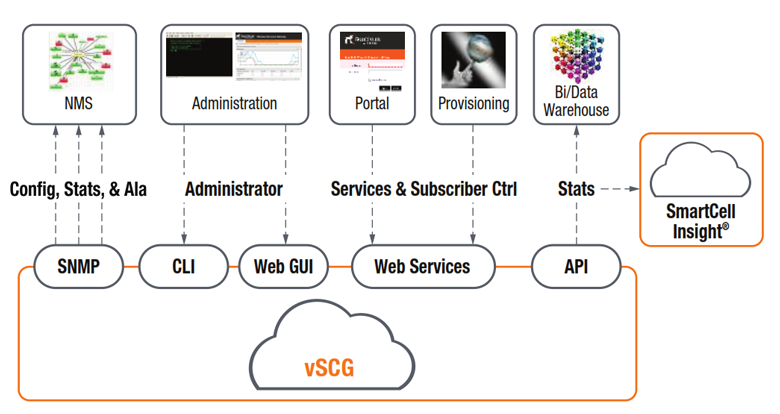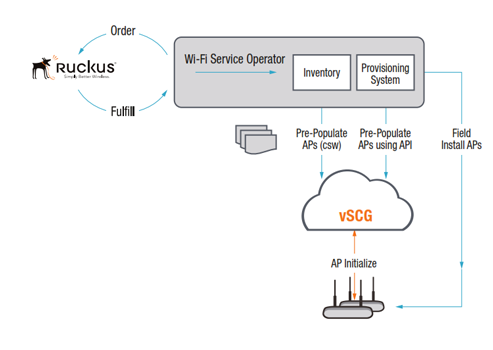
RUCKUS Virtual SmartCell Gateway
NFV-based WLAN Controller Designed for Service Providers and Enterprises

מחירים נוספים מופיעים למטה, או לחצו כאן!
Overview:
The virtual SmartCell Gateway (vSCG) is a scalable and versatile WLAN Controller designed to run in the cloud. It eliminates the difficulties operators are experiencing with building and managing very large-scale WLAN networks, and it is especially well suited to enabling a managed services offering.
By moving the SCG functionality into the cloud, it becomes possible to offer a platform with enormous scalability. This includes support for tens of thousands of RUCKUS access points and hundreds of thousands of subscribers per virtual instance. The vSCG provides all control plane functions, with data plane traffic being routed directly from the APs to a separate WLAN gateway. This approach is consistent with the industry trend toward Software Defined Networks (SDN) that split out the control plane from the data plane.
The vSCG can be deployed as a private cloud to support one specific network deployment, or in a public cloud that can support hundreds or even thousands of managed WLAN networks. The vSCG can run on either an open-source KVM hypervisor or the VMware vSphere hypervisor. The hypervisor function creates the virtual machines (VMs) that the vSCG application can run on. As traffic and load increases, the hypervisor can obtain additional resources from the underlying hardware layer to meet the demand. These resources can later be released as circumstances dictate.
The vSCG is especially effective at addressing the enormous opportunity in managed WLAN services for enterprises, small and medium business, and public venues. These organizations see WLAN service as business critical, but often do not have the IT infrastructure to support a truly robust deployment. They are looking to service providers to fill the void here, and the vSCG is a critical tool in enabling a very scalable and cost effective service.
Key Features/Benefits
Scalability
The vSCG is a virtualized WLAN Controller that runs in the cloud and can easily support networks with tens of thousands of APs and hundreds of thousands of users.
Flexibility
The vSCG can run in a public cloud where it can provide a managed WLAN service offering for an almost unlimited number of customers or a private cloud where it could be for the benefit of a single network deployment.
Managed WLAN Services and Multi-Tenancy
The multi-tenant capabilities of the vSCG enable many customers to share a single instance of the vSCG, or each managed services customer can have their own virtual instance of the vSCG.
High Availability
The vSCG supports Active/Active clustering across multiple data centers for very high availability.
Cost Effective
Customers only purchase licenses for the number of APs that need to be supported and additional licenses can be added for a pay-as-you-grow model.
Hotspot 2.0 Roaming Support
The vSCG supports the Wi-Fi Alliance Hotspot 2.0 release 1 specification, which enables mobile devices to automatically discover and select APs for which a roaming arrangement exists.
Location Capabilities
The vSCG can enable location-based services. These services require the addition of RUCKUS Smart Positioning Technology (SPoT), which also runs in the cloud.
Big Data Analytics and Reporting
Large-scale Wi-Fi networks generate an enormous amount of data on network performance. The vSCG can upload network statistics to the SmartCell Insight (SCI) platform.
Features:

Figure 1 shows how the vSCG would be deployed in an actual network. All control plane traffic flows between the RUCKUS access points and the vSCG in the cloud. All data plane traffic is routed directly from the RUCKUS access points to a WLAN gateway, without passing through the vSCG. This greatly simplifies network design as it allows the WLAN Controller function to be consolidated in a national data center, while the WLAN gateway function can reside in regional data center. This approach allows user data to be quickly routed via the most expeditious path to the Internet. RUCKUS supports L2oGRE (aka Soft GRE) for this data tunneling function. Soft GRE is supported by most WLAN gateways. The RADIUS Proxy function on the vSCG can greatly reduce the RADIUS traffic load on the WLAN gateways.
Highly Scalable and Fully Featured WLAN Controller
The vSCG has the scale and the feature set for the most demanding service provider applications. It has been designed with Network Function Virtualization (NFV) in mind, a central tenant of which is the decoupling of the application from the underlying hardware. By splitting out the WLAN control plane from the data plane, and then virtualizing the WLAN Controller application, the stage is set for an extremely versatile network deployment that is consistent with emerging industry trends (See figure 1). T
he vSCG WLAN Controller function provides feature-rich access point management, including control over their self-organizing smart networking behaviors such as RF management, load balancing, adaptive meshing, and backhaul optimization.
The following are some of the capabilities that are enabled by the vSCG WLAN Controller function.
WLAN radio resource management
The vSCG supports a variety of radio resource management techniques of which the most important is ChannelFly™. This algorithm allows APs to automatically select the optimum 2.4 and 5 GHz channels so as to maximize performance and minimize interference. When properly deployed, ChannelFly can double the capacity of a WLAN network in a high-density environment. The vSCG also manages dynamic mesh deployments that make use of the 5 GHz band to backhaul AP traffic to a point where wireline facilities are available. Mesh backhaul configurations can be dynamically reconfigured to reroute traffic over different paths as conditions change.
Seamless low-latency WLAN handoffs
The vSCG supports seamless handoff for subscribers as they move from one Wi-Fi AP to another in the coverage area. It is not necessary for the user to re-authenticate as they move about. Their credentials are passed from access point to access point. Handoffs are performed rapidly, and there is no impact on the application. The vSCG also supports Wi-Fi RAN load balancing.
Hotspot 2.0 based roaming
Hotspot 2.0 enables seamless network discovery and selection along with seamless authentication using 802.1x/EAP. It represents the future of Wi-Fi roaming and has picked up a tremendous amount of support from throughout the wireless industry. The vSCG supports Hotspot 2.0 by enabling RUCKUS APs to exchange information with Wi-Fi devices pre-association. The information that is exchanged includes details on roaming consortiums that are supportted by that AP as well as information on backhaul capacity and loading. The Wi-Fi device then selects the best available AP and begins the authentication process. Hotspot 2.0 is automatic and requires no user intervention.

Figure 2: The built-in EMS in the vSCG provides user-friendly fullfledged FCAPS support and can be easily integrated with existing OSS/BSS systems.
Operations and Administration (OAM)
Element management system
With the built-in EMS, the vSCG supports rapid deployment and eliminates the need for separate and expensive management systems. The built-in EMS provides user-friendly full-fledged FCAPS support and can be easily integrated with existing OSS/ BSS systems via a variety of interfaces ranging from traditional SNMP or CLI based interfaces to web programming friendly secure API based methods (RESTful JSON). See Figure 2.
Statistics, KPIs and reports
The vSCG's built-in EMS provides rich near real-time statistics on subscribers (including client fingerprinting), APs, SSIDs, mesh backhaul, and the vSCG cluster itself. Reports ranging from hours to years can be generated for a variety of key performance indicators (KPIs) and exported out in multiple formats. For operators seeking richer information reporting, RUCKUS also provides the SmartCell Insight (SCI) appliance for long-term storage, sophisticated data mining and analysis, and richer more complex reporting.
Access point configuration and management
Access point configuration is a key function of the vSCG and especially important when rolling out networks with tens of thousands or hundreds of thousands of access points. In a RUCKUS network deployment, access points will automatically connect to a pre-determined vSCG instance when they are installed in the field. They will identify themselves via MAC address and serial number, and then their configuration will be automatically downloaded along with their zone number. The configuration information for each AP is downloaded to the vSCG from an external provisioning system via a CSV file or an API (see figure 3).

Figure 3: Automatic Access Point Configuration is the process by which APs installed in the field can have their configuration automatically downloaded to them via the vSCG.

Figure 4: The vSCG runs on a virtual machine established by the hypervisor. It in-turn runs atop the physical x86 blade servers. When deploying the vSCG in a data center, the existing cloud service management and orchestration function can interface with the vSCG through an API. This enablethe rapid deployment of large numbers on managed WLAN networks in an extremely cost effective manner.
Managed Services
The vSCG's fully functional GUI provides concurrent role-based access control (RBAC) for viewing the Wi-Fi system resources and performance. With the support of partitioning for access in a secure manner, the vSCG allows service providers to give their managed services customers the ability to administer and monitor only the SSIDs over which they have control.
Virtualizing the SCG
This is a key capability that will accelerate the deployment of managed WLAN services. It involves running the vSCG application and its OS on top of either the KVM or the VMware vSphere hypervisor. Virtualization enables a whole host of new capabilities including:
- Ability to dynamically add hardware resources as required to support the needs of a specific managed services customer, and those resources can be released just as easily. This enables a much more efficient use of data center resources.
- High availability by enabling the hypervisor to shift applications to different server modules to address failures. The vSCG application can also run in Active/Active mode for extremely high availability.
- The vSCG is well suited to deployment in a service provider's data center and it can support usage-based charging models
- Managed services customers can be assigned their own VM or they can share a VM in a multi-tenant environment as circumstances dictate. The latter is an extremely cost effective way of virtualizing the SCG function.
| Key vSCG features | |
| Monitoring |
|
| Remote troubleshooting |
|
| Simplified deployment |
|
| Reporting |
|
| One-click provisioning |
|
Specifications:
| Virtual SmartCell Gateway Specifications | |
|---|---|
| Supported Configurations | |
| Managed APs |
|
| Concurrent Mobiles (UEs) / Stations |
|
| WLANs |
|
| Controller Expansion |
|
| Controller Redundancy |
|
| Key Functionality | |
| Data Offload |
|
| Authentication Protocols |
|
| AAA Service |
|
| Hotspot 2.0 |
|
| WISPr Support |
|
| Element Management |
|
Documentation:
Download the RUCKUS Virtual SmartCell Gateway Datasheet (PDF).
הערות תמחור:
- שימו לב: כל המחירים באתר כוללים מע"מ.
- החיוב יבוצע על פי שער "העברות והמחאות מכירה" של המטבע (דולר אמריקאי) ביום אישור ההזמנה.
- מחירי המוצרים וזמינותם כפופים לשינויים ללא הודעה מוקדמת.
המחיר שלנו: הצעת מחיר
המחיר שלנו: הצעת מחיר
המחיר שלנו: הצעת מחיר
המחיר שלנו: הצעת מחיר
המחיר שלנו: הצעת מחיר
המחיר שלנו: הצעת מחיר
המחיר שלנו: הצעת מחיר
